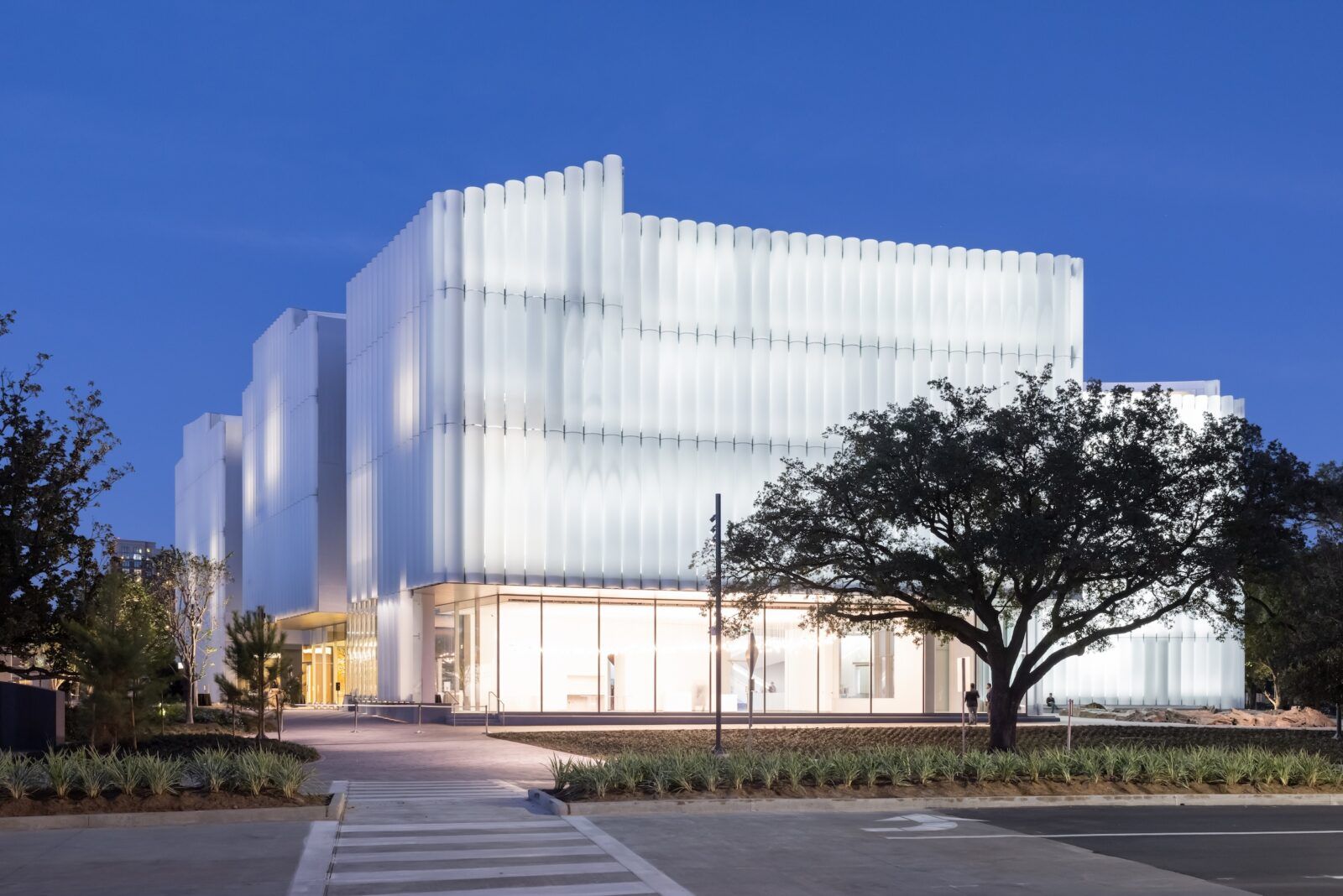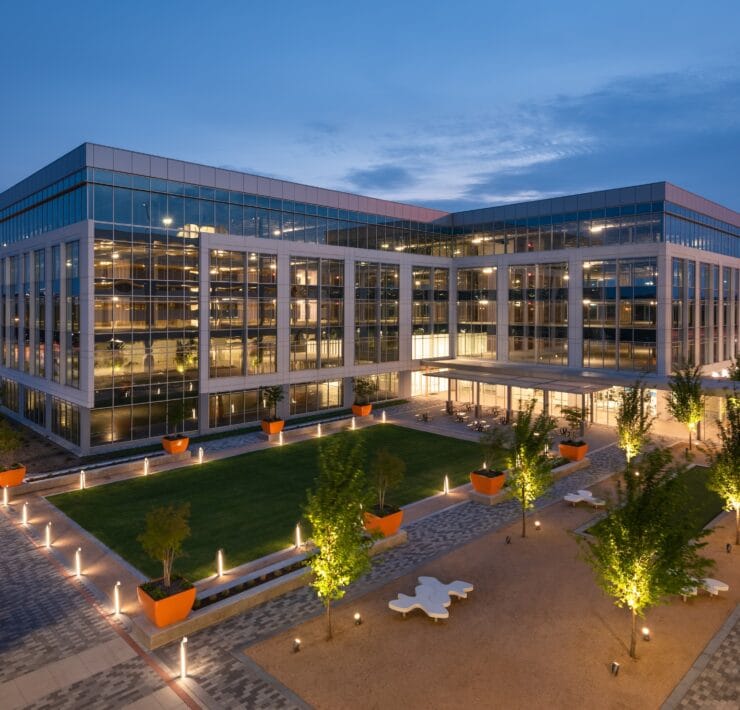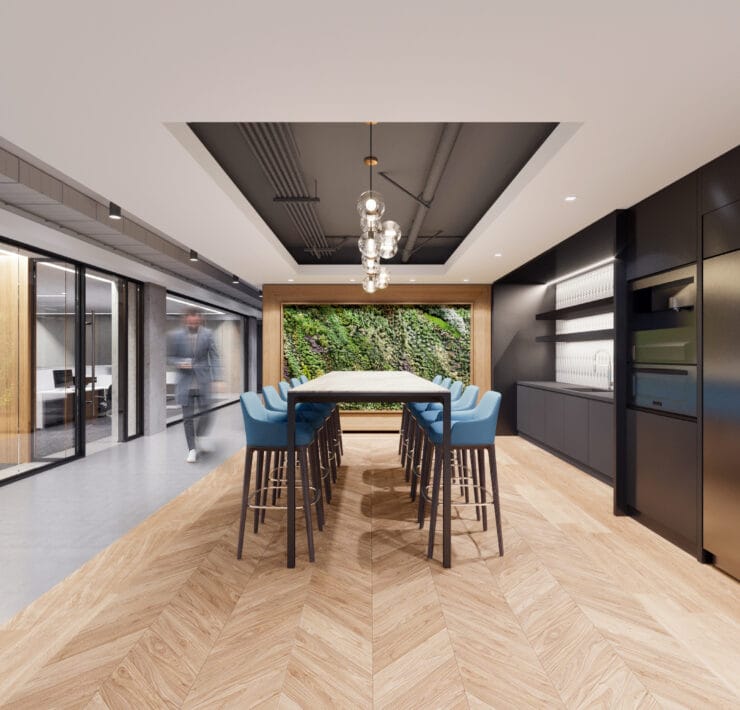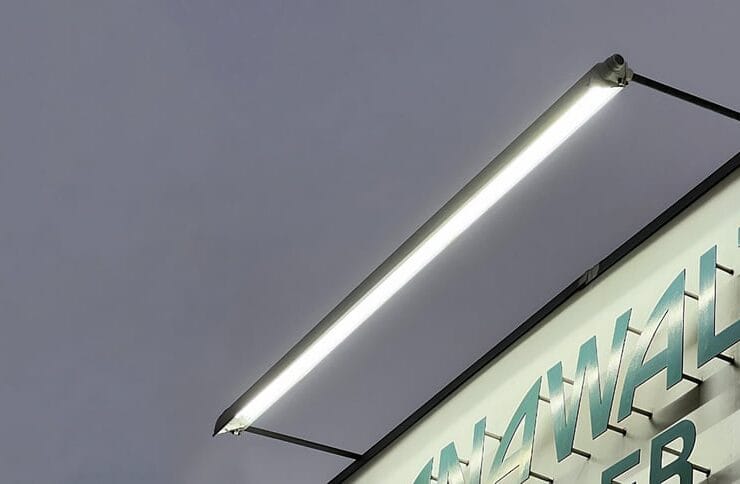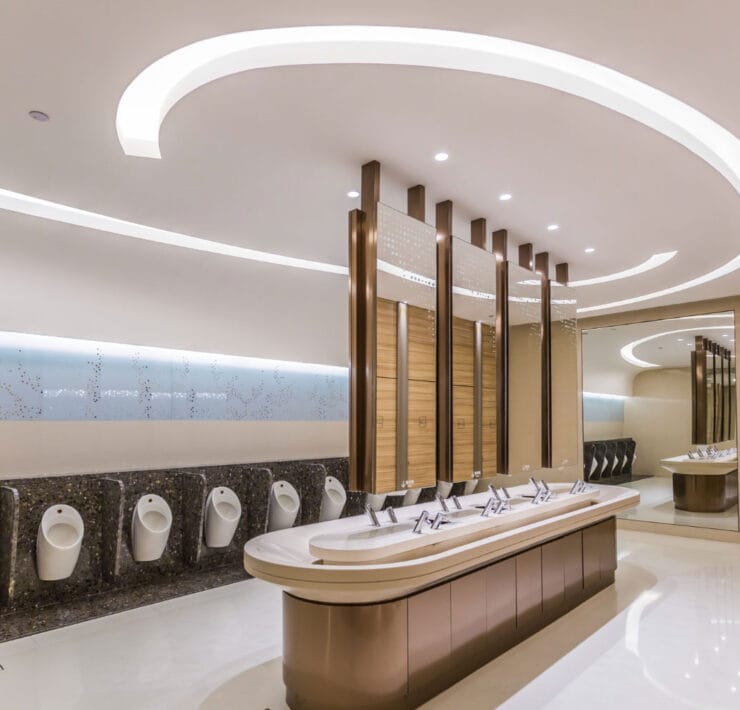Illuminating facades is an art. Developing and executing facade lighting plans requires both creative and technical processes. This post explores the methods and impacts of successful facade lighting.
Architectural lighting design serves and enhances certain architectural elements to foster, establish or emphasize a building’s aesthetic, history and purpose. Facade lighting complements and elevates exterior architecture elements. Facade lighting can apply to any type of architectural project, but the building use should guide the lighting design. Hospitality facade lighting could be inviting, warm and attention-grabbing, yet tactful. High-end restaurants benefit from more elegant and decorative facade lighting. Retail facade lighting should match the company branding and benefit from unique and elaborate designs. Facade lighting is a powerful way to highlight architectural exteriors, reveal materiality and transform how a building or structure appears at night. The strategies described focus on non-residential projects.
Table of contents

Light levels
When designing the lighting for a building facade, pedestrian safety, energy consumption and effects on people and the environment must all be considered. To understand lighting principles that minimize light pollution and other undesired effects, review this guide on dark sky lighting. Instead of focusing on targeting the horizontal illuminance levels that create comfortable spaces to inhabit, facade lighting is more focused on executing lighting concepts with the appropriate light levels that express the architecture. Architectural facade lighting transforms a project’s surrounding community at closer and farther scales, impacting the experience of the immediate areas surrounding the building.
To begin a facade lighting design, first determine the baseline footcandle illuminance to target. Lighting zones categorize the amount of light that is appropriate for a project based on the urban density of its location (LZ4 is the most dense category, while LZ0 is the most without urban activity).
- For the most common active urban lighting zone (LZ3), assuming a medium reflectance facade material, the target illuminance should range from 0.2-1.5 footcandles.
- For any step up or down in the lighting zone category, multiply the target footcandle amount by 2 or divide by 2 accordingly (for example, LZ2 would target 0.1-0.8 fc).
- Similarly, if the facade material has a high or low reflectance, multiply or divide the target footcandle amount by 2 accordingly (example: low reflectance material in LZ3 should target 0.4-3 fc).[1]
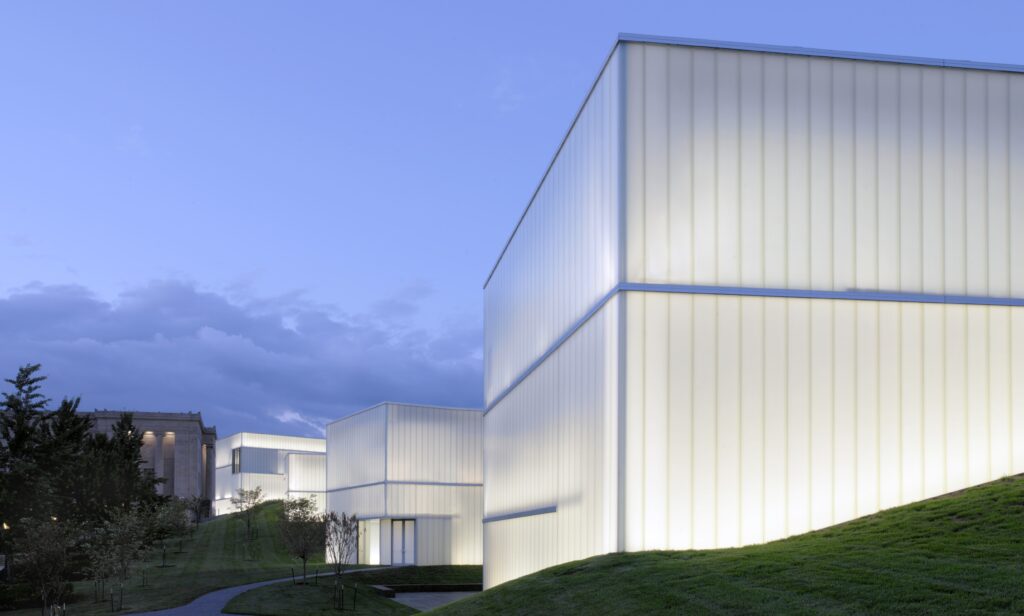
Use these suggested footcandle illuminance levels to specify the right lighting fixtures for a facade. Contrasting the light levels between different architectural facade components is an important step in developing a hierarchy of how the design is experienced. Also, special elements, such as building entrances, may benefit from higher light levels. A building entrance (in Lighting Zone 3 with a medium reflectance material) should target up to four footcandles on the ground and two footcandles vertically. If downward-oriented facade lighting is also intended to light a pedestrian path, target three footcandles.
Lighting fixture manufacturers are great resources to assist in selecting the fixtures that meet a project’s target illuminance goals. Using fixture samples to test a desired effect is also effective in the lighting design process. In order to find the right types of facade lighting fixtures, first define the architectural facade concept that you wish to achieve.
Facade lighting strategies & techniques
Facade lighting expresses design ideas by complementing architecture. An architectural project may have an existing exterior design, structure, material or pattern that should be captured through artificial lighting. Executing facade lighting requires using the appropriate fixtures and techniques to create the desired effects.
Large-sized architectural facade elements, such as walls, paneling, signs and roofs, are often illuminated with flood lighting, point sources or linear lighting. Lighting to graze a facade element typically benefits from placing the light source close to the target surface. The grazing effect reveals material texture and is best accomplished with fixtures that use a tight beam spread projected along the material’s surface.

Conversely, the wall wash lighting effect provides an even illumination across a surface. Wall washing is best accomplished with fixtures that spread the distribution of light along that surface, and benefits from placing the fixture further from the target surface. Use surface-mounted linear wall wash fixtures or in-ground linear wall wash fixtures for wall wash or wall grazing conditions. Using colored lighting (RGBW) is also a great way to create a saturated color effect on a facade.
Exterior uplighting has a few key differences in its effect versus downlighting. Downlighting sources are typically placed further from the viewer as they are mounted from above, which may be comfortable to view while capable of providing pedestrian lighting on the ground. Uplighting expresses a direct relationship with the ground while creating a unique effect as it is directed towards the sky. Using outdoor downlighting is a discrete method of creating a pattern of illumination for facade elements as well as outdoor circulation lighting. In-ground uplights can create a patterned succession of light against a facade, as well as illuminate the underside of a canopy.
Flood lighting is a simple and affordable way to illuminate a wall or other large facade element. Flood lights can be mounted in various ways, and illuminate an entire facade with limited fixtures. Wall packs and other wall-mounted fixtures are also effective for lighting a facade. Wall-mounted fixtures can bring an elegant touch and complement an architectural language.
Special facade lighting techniques also include the use of direct-view fixtures, continuous lighting fixtures, translucent material glow techniques, facade perforations, gobo projectors, framing projectors and much more. Direct-view lighting fixtures are designed for people to view the fixture’s luminance directly and are often used to outline architectural elements. Colored RGBW direct-view fixtures are effective for creating a visually compelling architectural language. Integrating openings to a facade, which allow light to shine out, can create a design relationship between interior and exterior spaces. The use of projector lights is another exciting method for highlighting specific facade elements or showing patterns on a surface. Choosing the right technique for lighting a facade is critical to the success of the design.
High-level concepts and precedents
Integrate lighting design with the facade. When light and materiality harmonize, the final product is transformative. Facade lighting can captivate pedestrians and elevate communities. Facade lighting may be discreet or provocative, so take the environmental setting into consideration.

Shown above, directional flood lighting artistically illuminates the elegant curves of the REACH Kennedy Center for Performing Arts. This method of using multiple flood lights oriented along the sweeping facade evenly renders the building’s exterior void spaces while maintaining the asymmetric language of the design. The illuminated forms contrast the evening sky to create an inviting outdoor atmosphere. This lighting approach complements the smooth but textured materiality of the solid forms.

Shown above, the facade of The Nelson-Atkins Museum of Art reveals glowing volumes emerging from the landscape. Linear lighting is integrated intoto the interior of the facade to illuminate the translucent materials. The effect of this glow that wraps the architectural forms is a symbol of the city for miles around. Applying this single technique to the layers of the facade masses creates an ethereal floating effect.
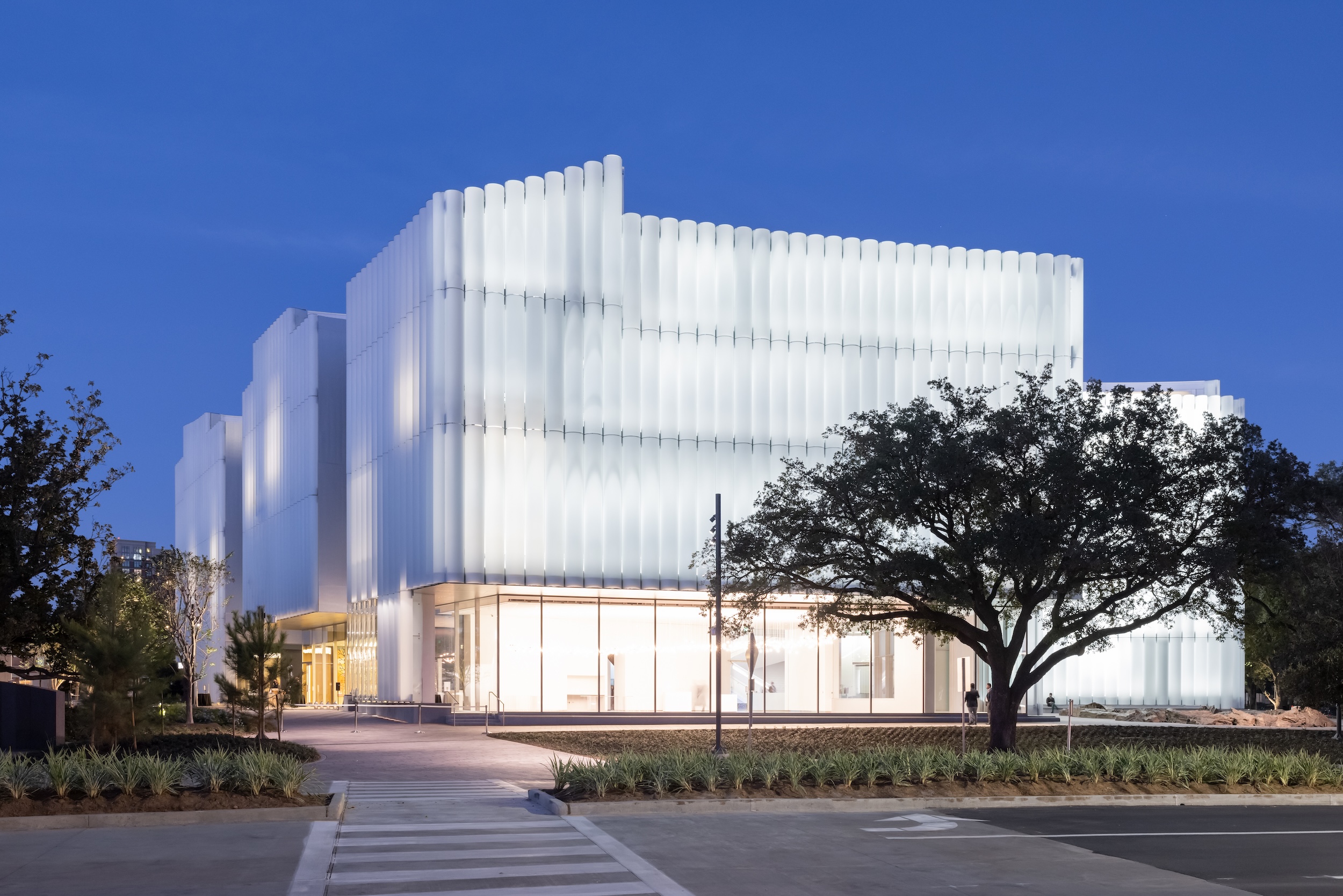
The Nancy and Rich Kinder Museum of Fine Arts combines translucent facade glow with perforations from the interior for an engaging design. The surrounding glass tube curtain wall is illuminated from within. The technique of allowing specific moments of light to shine through the material, suggests energy from programs inside. The contrast between bright and dark conditions along the facade transitions the facade’s language from a glowing volume to a discreet playfulness of the pedestrian experience. The moments of light that penetrate the promenade-facing facade invite the curiosity of the public.
Façade lighting regulations
Lighting regulations apply to conditions specific to building facades. These regulations benefit energy savings as well as mitigate negative effects on the environment. BUG lighting, lighting controls and wattage allowance requirements are all important facets of these regulations.
In California’s Title 24 Energy Regulations (similar to most other jurisdictions in the U.S.), BUG Rating (Backlight, Uplight and Glare) requirements apply to all fixtures producing 6,200 initial lumens or more.[2.1] If the outdoor fixture intended meets this requirement to follow the BUG Rating regulations, the subsequent Lighting Zone of the project must be referenced. Lighting Zones directly correlate to the amount of backlight, uplight and glare allowed for any given outdoor fixture producing more than the maximum allowable lumens.

All exterior lighting must be controlled separately from indoor lighting. Wall packs mounted 24 feet or lower require motion sensors. Also, “all outdoor sign lighting shall be controlled with a photocontrol in addition to an automatic time-switch.”[2b] While time controls are not required for most facade lighting, it is still a good idea to use time controls and photosensors. It is beneficial to turn off facade lighting at an appropriate time to mitigate skyglow and negative effects on wildlife.
Title 24 regulation directly addresses the allowed wattage for building facade lights. Facade lighting is only allowed in Lighting Zones 2 through 4, and is calculated using the surface area of the facade that is illuminated. For the most common category, Lighting Zone 3, 0.17 watts per square foot is allowed. For Lighting Zone 2, 0.1 watts per square foot is allowed.[2.3] Add all the wattage for the luminaries used for the given facade area to make sure they remain less than the total allowable wattage. Some exterior conditions, such as building entrances and other types, permit extra allowable wattage. Building entrances for Lighting Zone 3 allow for 19 watts for each door. For externally illuminated signs, 2.3 watts per square foot is allowed. Consult the regulations in a given project’s jurisdiction for the applicable facade lighting allowances.
Conclusion
Integrating facade lighting into the building design process brings architecture to life. Facade lighting enables architecture to transform as day transitions to evening. Use facade lighting to create an exciting and phenomenal outdoor environment. Being mindful of the appropriate light levels, energy consumption and potential effects on people and wildlife are all important when developing any facade lighting design. Follow these techniques described to create an impactful facade lighting scheme.
Sources:
[1] IES. RP-43-22 Recommended Practice: Lighting Exterior Applications. 2022. Page 27-38: Light levels. [2] California Energy Commission. Title 24, Part 6. Building Energy Efficiency Standards. 2022.- Page 211: BUG rating
- Page 411: Lighting controls
- Page 472: Lighting power allowance
Garrett Rock is a seasoned lighting designer based in San Francisco, California. He earned his bachelor's degree in Interior Design from the University of California, Davis, and a Master's in Architecture from the California College of the Arts. Throughout his career, Garrett has contributed to firms such as Architecture & Light, Banks Landl Lighting Design, Geddes Ulinskas Architects and WSP. He currently serves as a lighting design consultant for Alcon Lighting and a technical writer for Insights, where he specializes in keeping readers current on energy regulations and in human-centric lighting guides for healthcare settings, retail and other commercial applications.

